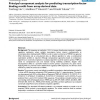886 search results - page 109 / 178 » On the Autoreducibility of Random Sequences |
RECOMB
1999
Springer
14 years 1 days ago
1999
Springer
An important goal in bioinformatics is determining the homology and function of proteins from their sequences. Pairwise sequence similarity algorithms are often employed for this ...
BMCBI
2007
13 years 8 months ago
2007
Background: Expressed sequence tags (ESTs) analyses are a fundamental tool for gene identification in organisms. Given a preliminary EST sample from a certain library, several sta...
BMCBI
2008
13 years 8 months ago
2008
Background: Recent approaches for predicting the three-dimensional (3D) structure of proteins such as de novo or fold recognition methods mostly rely on simplified energy potentia...
BMCBI
2005
13 years 7 months ago
2005
Background: The large gap between the number of protein sequences in databases and the number of functionally characterized proteins calls for the development of a fast computatio...
BMCBI
2005
13 years 7 months ago
2005
Background: The responses to interleukin 1 (IL-1) in human chondrocytes constitute a complex regulatory mechanism, where multiple transcription factors interact combinatorially to...

